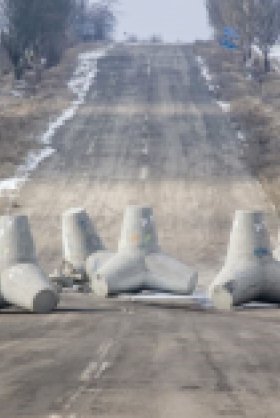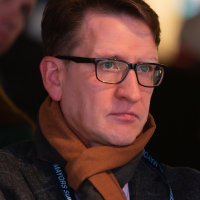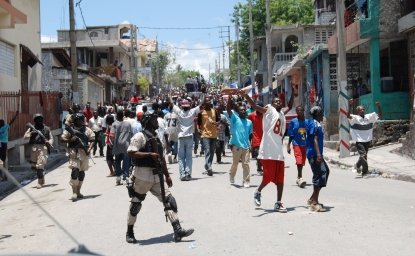Kennan Cable No. 35: Institutional Paths to Ending the Donbas Conflict


Ever since the armed conflict in Donbas started in 2014, Washington and Kyiv have seen its resolution through the prism of altering Russia’s behavior in the region. As Kurt Volker, the U.S. special representative on Ukraine, often notes, Moscow can quickly resolve the conflict by withdrawing its troops from Donbas, ending arms supplies to separatists, and allowing local elections under international control.[1] This explains why Western sanctions have been tied to Russia’s implementation of the Minsk Agreements.[2] However, the successful reintegration of Donbas into Ukraine requires more than ending Russian military presence and restoring Kyiv’s control over the border. It rests on designing a new institutional framework that can provide long-term guarantees to civilians and separatist insurgents and prevent conflict recurrence. Responsibility for the adoption of new institutions lies primarily with the Ukrainian authorities. So far, they have avoided publicly discussing the specifics of a long-term settlement. Moreover, the idea that resolving the conflict would require the adoption of a special set of rules for the region, as outlined in the Minsk Agreements, remains highly controversial among Ukrainian political elites.[3] However, lack of credible institutional guarantees for the separatist side would undermine any prospect of implementing a peace agreement. Details of a new institutional arrangement in Donbas should be a vital aspect of any viable conflict-resolution strategy. The end of similar conflicts in other parts of the world offers a guide in searching for the most appropriate institutional solutions for Ukraine.
Power-Sharing Options in Donbas
Ukraine’s current constitutional design is particularly ill-equipped for resolving the type of armed conflict that has been raging in Donbas. The president’s outsized role in decision-making makes policy outcomes reflective of the majoritarian logic of the zero-sum competition for the office. It also gives the president leverage in dealing with local authorities through appointment and dismissal of heads of local administrations and dissolution power of local assemblies. Recent decentralization reforms put local governments in charge of the provision of education and healthcare services and increased their fiscal powers through new tax allocation rules. However, they did not empower local communities to influence the content of their educational programs or design their own cultural, linguistic, or historical preservation policies.
Any negotiated settlement of the conflict would then require the introduction of power-sharing measures that would guarantee local governments control over issues of most concern to the communities. Following the end of the Cold War, power-sharing provisions have been included in over two-thirds of the settlements of intrastate conflicts.[4]
Political and military power-sharing models primarily intend to resolve conflict over central government control between ethnic groups relatively equal in size and, hence, require institutional changes on the national level. But executive power-sharing with government quotas, guaranteed representation, and veto powers for regional representatives would have an adverse effect on the peace process in Ukraine and its state capacity. It would allow a relatively small, region-based group to obstruct national decision-making and turn state institutions into arenas of permanent and inconclusive contestation between competing visions of the Ukrainian state.
Territorial or economic power-sharing, by contrast, targets small secessionist groups and addresses local incompatibilities without necessitating changes in the composition or decision-making procedures of the central government. This makes them particularly fitting for the type of conflict that Ukraine has experienced since 2014. Territorial autonomy that affords local governments in Donbas broad powers in certain policy domains would not threaten effective policy-making or institutional capacity on the national level. Rather, it will allow the resolution of key incompatibilities behind the conflict. It will give the region expanded self-governance powers it has long sought, including the right to design its own educational and cultural policies, choose its historical preservation priorities, and maintain cross-border ties with Russia. While the region will not have veto power over Ukraine’s foreign policy strategy, economic power-sharing may allow local industry to continue trading with Russia with minimum barriers through the creation of a special regional trade zone. The region could also maintain access to Russia’s cultural space and engage in various cross-border cooperation and exchange projects. Territorial autonomy coincides with the current preference of residents of separatist-controlled areas of Donbas, where the majority prefers “special status” either within Russia or Ukraine.[5]
The risks associated with territorial power-sharing should be lower in Ukraine’s case. Since the conflict is not driven by interethnic confrontation, there are fewer opportunities for ethnification of issues in political competition. In the absence of other regions with a similarly strong regional identity or non-titular ethnic majority, the risk of “contagion” of autonomy demands from other regional leaders is also low. Still, the central government needs to pursue inclusive cultural and linguistic policies on the national level to effectively reintegrate local Ukrainians into the broader political community and increase their identification with the Ukrainian state.
The most serious risk associated with autonomous status for Donbas is the prospect of giving local leaders legal institutional weapons to strengthen their political dominance and, potentially, challenge the central government. Whenever segmental institutions give stronger leverage to segment-state leaders there is constant pressure for further devolution of power leading to potential nation-state crisis.[6] It can lead to the hegemony of regional identity, collective action directed against the central government, and consolidation of regional elites embedded in autonomous patronal structures (with independent distribution of rewards and punishments).
There are several possible remedies to prevent the types of problems associated with segment-states. First, territorial autonomy should be granted to the entire Donetsk and Luhansk oblasts rather than just to the two separatist-controlled enclaves. As one recent poll shows, residents of Ukraine-controlled Donbas are more likely to identify themselves as Ukrainian citizens and speak Ukrainian in their daily lives.[7] They are also more likely to support Ukraine’s pro-Western foreign policy and express distrust in Russian leadership, even though a strong majority in both parts oppose integration with the EU or NATO. The merger of the two parts of Donbas will thus allow for a natural diversity of views and orientations in the region. This will serve as an important barrier against both the consolidation of regional identity antagonistic to Ukraine and the establishment of a political monopoly by actors associated with the separatist forces.
Second, an insight from the work of a political scientist Philip Roeder about power-dividing or multiple-majority strategy of conflict resolution should guide the design of a new institutional makeup of Donbas. Its goal, he writes, is to divide a majority within a group “among multiple crosscutting majorities and minorities,” which would “foster through politics the development of dispersed rather than cumulative cleavages.”[8] In effect, this means shifting power within territorial autonomies to directly elected mayors and city assemblies that would set their own policies to correspond with local preference. The emerging ideational diversity of Donbas will then find its expression in diverse policies adopted on the town and village level.
This strategy would help prevent the centralization of political control over the region in Donetsk and Luhansk and avoid the imposition of policies reflecting solely the views of a concentrated majority on the entire region. The power of new political leaders originating from the separatist government would be bounded by those localities where they could garner majority support. Their “institutional weapons,” to use Roeder’s terms, would, thus, be effectively localized. This would limit their capacity to coordinate broader anti-government actions or reframe the region’s history and identity.
The stability of the post-conflict settlement would be further enhanced if any changes to the terms of the agreement, particularly regarding territorial power-sharing, require ratification by the localized majorities across Donbas. It would serve as a reassurance mechanism for regional elites that the fluidity of ruling coalitions or executive turnover will not affect the terms of the settlement. The current law on the “special status” of separatist-controlled territories should be viewed as a transitional framework set for renegotiation with new regional representatives once local elections are held. However, the territories should keep their “special status” until they reach an agreement on a permanent institutional settlement.
Rebel Disarmament, Demobilization, and Conversion
Reaching an agreement on power-sharing is one precondition for beginning to disarm and demobilize combatants in civil wars. Another component is the inclusion of former rebels in the competitive political process through “rebel-to-party transformations.”[9] The practice of pursuing such transformation through formal or informal agreement between combatants has been almost exclusively a post-Cold War phenomenon.[10] One cross-national study indicates that the presence of a rebel party in post-war institutions increases the short-term and long-term durability of peace.[11] Integration of the party tied to former rebel groups can eliminate potential spoilers, develop stakeholding in the new system, provide non-violent means of conflict resolution, make them more accountable to their constituency, and increase legitimacy of the election process and new authority structures. However, some of the positive effects from rebel conversion depend on the prior organizational structure of separatist groups and their political wings. Groups with a highly integrated political and military structure are the least likely to undergo a successful transformation into an exclusively political force.[12] This points to major challenges in achieving rebel conversion in Donbas.
The leaders of the armed groups in Donbas have already established their own political organizations, which participate in separatist-administered elections, control local councils throughout the conflict region, and engage with residents. They have turned into what a security analyst Benedetta Berti calls “hybrid politico-military organizations” tightly linking political activities and armed struggle.[13] In both “republics” military and political wings are subordinated to a single leader. DPR’s two major political factions represented in the “republican” assembly are “Donetsk Republic” (DR), chaired by current DPR leader Aleksandr Zakharchenko, and “Free Donbass,” tied to early separatist leader Pavel Gubarev. The dominant political organization in LPR is “Mir Luganshine” (ML), chaired by current LPR leader Leonid Pasechnik. All three position themselves as civic organizations aimed at providing social services and welfare assistance to residents of their respective territories. At the same time, they organize party congresses, run youth groups, and participate in the electoral process.
On one hand, the cohesiveness of the political and military wings of the separatist forces and their integrated leadership can make it easier to achieve disarmament and conversion into an institutionalized political party. They offer ready-made organizational vehicles for separatist activists, with developed clientelistic networks extending from the cities to smaller towns. This gives them “convertible capabilities” that substantially improve their electoral prospects, as Jennifer Raymond Dresden writes recently in Conflict Management and Peace Studies.[14] Some evidence suggests that the provision of services by rebel groups improves the electoral performance of their parties.[15] Hence, leaders of separatist groups in Donetsk and Luhansk can endorse disarmament and demobilization without fear of being marginalized politically.
However, an integrated political-military structure also presents three important challenges for successful transition into the political arena. First, in contrast to political wings of rebel forces in other countries, these organizations emerged as key tools for separatist governance in DPR and LPR. Their ideological program promotes independence for these regions and would be incompatible with participation in Ukraine’s institutional politics. Their reintegration would require a major revision of their principles and goals with an emphasis on accommodation with the Ukrainian state and acceptance of its jurisdiction over the entire region. Otherwise, their inclusion in the political process risks deepening the war-based dividing lines and hampering reconciliation. Second, the centrality of the leaders of these groups in organizing an armed struggle against Ukrainian forces and their direct involvement in the fighting delegitimizes them in Ukrainian public opinion and with the central government. The recently adopted law on “temporarily occupied areas of Donetsk and Luhansk oblasts” describes the ruling structure of the “republics” as an “occupational administration of the Russian Federation.” This further complicates their post-conflict acceptance as legitimate regional representatives. Hence, leadership turnover in separatist groups is a crucial precondition for the beginning of their direct talks with the Ukrainian authorities. Finally, the current control that DPR/LPR leaders exercise over the separatist military apparatus means that even following disarmament and demobilization they would maintain some influence over local law enforcement. This, in turn, would allow these leaders to rely on an informal personal militia after demobilization or revive the military component of their organizations if they sensed a threat to their power status.
The conversion of rebel groups into recognized political organizations could be one of the most complex and contested elements of the transition. However, without the inclusion of separatist groups in the political process the prospect of reaching an election phase will be dim. Furthermore, the pacifying effect of elections will depend on the extent to which formerly separatist political organizations subsequently have sufficient freedom to maintain their grass-roots operations and engage with their constituencies.
Transitional Justice Mechanisms
The successful demobilization and reintegration of former rebels also depends on their post-conflict legal status. If the government reserves the right to prosecute former rebels for any crime committed during the war it creates incentives for spoiling and precludes the possibility for converted rebel groups to compete on equal terms with other political parties. Hence, comprehensive amnesty, or the promise to not prosecute or punish conflict-related offenders, has been the most common type of transitional justice tool during and following civil war. Two-thirds of 96 post-conflict amnesties granted between 1946 and 2006 were comprehensive and unconditional and less than 20 percent were limited to certain categories of combatants.[16] The likelihood of conflict decreases by 35 percent if the government grants amnesty.[17]
Comprehensive amnesty may be the most effective transitional justice tool in the case of the armed conflict in Donbas. While the Ukrainian authorities insist on accountability for separatists responsible for war crimes and human rights violations, this strategy can be achieved only in the case of a decisive victory of the government side. The sheer scale of military mobilization on the rebel side, more than 50,000 people in four years of conflict, makes thorough investigation of each case impossible for Ukrainian law enforcement. Moreover, investigations and accountability for human rights abuses committed by the government side would be even less feasible. Any attempts to prosecute former rebels would then make the government susceptible to charges of pursuing selective persecutions and individual vendettas. It would destabilize the implementation of the agreement and increase the likelihood of a violent backlash.
Still, some form of accountability can be achieved using other transitional justice mechanisms compatible with the goal of ending the conflict in Donbas. The most effective is the institution of the truth commission, like the ones created following civil wars in El Salvador and Guatemala. One study of truth commissions established in eight post-conflict countries between 1946 and 2006 showed that there was no civil war recurrence in any of the cases.[18] Truth commissions help to sustain peace by allowing citizens to articulate grievances, establishing a record of past crimes, identifying perpetrators, and offering public acknowledgement of individual or group culpability. Their findings can also help establish a common narrative of the conflict and create a shared factual basis for dialogue and peace building. Commission reports can also provide grounds for banning those responsible for war crimes and major human rights violations from holding office or even participating in the political process. At the same time, they do not lead to criminal prosecution and, hence, minimize incentives for spoiling, especially on the part of paramilitaries or rebel leadership.[19]
Election Timing and Participation
Post-conflict elections have become an increasingly common tool of political stabilization following the end of hostilities. Electoral participation provisions have been included in almost half of all peace agreements signed after 1989.[20] Their inclusion is associated with a lower likelihood of conflict recurrence compared to agreements without such provisions.[21] However, the impact of their implementation on preventing conflict recurrence remains a contested issue. Some suggest that early post-conflict elections tend to favor former rebel parties, which may allow them to fortify their political dominance and marginalize mainstream political forces.[22] In the absence of functioning political institutions such dominance may result in the creation of authoritarian enclaves, reinforcement of regional alienation, and breakdown of power-sharing agreements.[23] Finally, a rush to elections in unsettled conflict may deepen pre-existing social fissures and increase internal polarization, thus complicating further progress in conflict resolution.[24]
The findings on the effects of post-conflict elections strongly suggest the need for a transitional period of two to three years before regional elections are held in Donbas. An accelerated election schedule will intensify political contestation, particularly between official Ukrainian parties and rebel-related political forces. It will also complicate electoral participation for millions of refugees who fled to Russia or those displaced from Donbas to other parts of Ukraine. Holding elections in a volatile post-conflict environment creates ample opportunities for voter intimidation, electoral fraud, and disinformation campaigns that could build on conflict-related divisions. Furthermore, a level playing field for all would require the creation of a transitional political authority with equal representation from former rival sides and, possibly, international organizations. There should also be an independent electoral board consisting of international and regional representatives to oversee the campaign and ensure a fair outcome. The importance of establishing a secure environment and achieving procedural fairness dictates a longer preparation phase for elections in order for them to have a pacifying effect. Finally, the holding of elections cannot become the endpoint of a peace process. Rather, elections are a mechanism of establishing legitimate regional authority, which can then start the process of negotiation with Kyiv over the terms of a final peace settlement.
Conclusions
The armed conflict in Donbas has reached a stalemate, which requires all sides to consider alternative solutions short of victory. Empirical studies of similar conflicts offer four key insights regarding the optimal institutional paths to a lasting peace.
First, territorial power-sharing that would grant broad autonomy to the region has been the most effective institutional mechanism of dividing state power with former rivals. It may be particularly applicable to the Donbas conflict given its territorially bounded and non-ethnic character. At the same time, a variety of risks associated with creating a possible segment-state call for the adoption of a strategy of divided majorities, to prevent the centralization of power within new autonomous provinces and to create cross-cutting cleavages that would weaken regional identity.
The second insight points to the importance of allowing rebel conversion into legitimate political parties that would pursue their goals through institutionalized, non-violent channels. The presence of integrated politico-military organizations in DPR/LPR makes it easier to accomplish such a conversion, but also poses a variety of risks. There needs to be a comprehensive change in the ideology and leadership of these organization for them to become legitimate actors in the Ukrainian political arena.
The third insight calls for a comprehensive and unconditional amnesty granted to all participants of the armed conflict. The granting of such an amnesty has been a frequent feature of transitions following negotiated agreements and has improved the chances of stable post-conflict outcomes. At the same time, a truth commission could be used to establish a degree of accountability for crimes committed by both sides during the conflict and to create a shared factual narrative of its causes and dynamics.
Finally, despite the positive effects that elections have in a post-conflict environment, a rush to the polls can also reinforce existing divides and raise doubts about the fairness of the process. A delay in holding elections would enable the formation of an independent electoral commission, ensure a level playing field for all political actors, and allow for a return of millions of refugees and internally displaced people.
In order to achieve any breakthrough in the implementation of the Minsk Agreements, policy-makers need to move away from exchanging ultimatums and attributing blame to a more systematic discussion of the specifics of post-conflict institutional design. Social science research can add important nuance to these discussions and allow for the analysis of the Donbas conflict in the comparative context. Although academic findings can serve only as guidelines for policy, they offer the most rigorous proposals regarding various ways to reach a durable settlement.
[1] “U.S. Envoy: Lack of Political Will in Moscow Thwarting Ukraine Peace,” RFE/RL, January 24, 2018, https://www.rferl.org/a/ukraine-volker-russia-willingness-end-conflict/28994196.html.
[2] “Remarks by High Representative/Vice-President Federica Mogherini at the Joint Press Point with Mr. Petro Poroshenko, President of Ukraine,” European Union (website), March 12, 2018, https://eeas.europa.eu/headquarters/headquarters-homepage/41174/remarks-high-representativevice-president-federica-mogherini-joint-press-point-mr-petro_en.
[3] Can Peacekeepers Break the Deadlock in Ukraine? Report No. 246 (Brussels, Belgium: International Crisis Group, December 15, 2017).
[4] Caroline Hartzell and Matthew Hoddie, “The Art of the Possible: Power-Sharing and Post-Civil War Democracy,” World Politics 67, no. 1 (2015): 37–71.
[5] Gwendolyn Sasse, The Donbas—Two Parts, or Still One? The Experience of War through the Eyes of the Regional Population, ZOiS Report 2/2017 (Berlin, Germany: Centre for East European and International Studies, May 2017).
[6] Philip Roeder, Where Nation-States Come From: Institutional Change in the Age of Nationalism (Princeton, NJ: Princeton University Press, 2007).
[7] Sasse.
[8] Philip Roeder, “Power Dividing as an Alternative to Ethnic Power Sharing,” in Sustaining Peace: Power and Democracy after Civil Wars, ed. Philip Roeder and Donald Rothchild (Ithaca, NY: Cornell University Press, 2005), 62.
[9] Terrence Lyons, “Soft Intervention and the Transformation of Militias into Political Parties,” in Strengthening Peace in Post-Civil War States: Transforming Spoilers into Stakeholders, ed. Matthew Hoddie and Caroline Hartzell (Chicago, IL: University of Chicago Press, 2010).
[10] Mimmi Söderberg Kovacs and Sophia Hatz, “Rebel-to-Party Transformations in Civil War Peace Processes 1975–2011,” Democratization 23, no. 6 (2016): 990–1008.
[11] Michael Christopher Marshall and John Ishiyama, “Does Political Inclusion of Rebel Parties Promote Peace after Civil Conflict?” Democratization 23, no. 6 (2016): 1009–1025.
[12] Benedetta Berti, Armed Political Organizations: From Conflict to Integration (Baltimore, MD: Johns Hopkins University Press, 2013).
[13] Ibid.
[14] Jennifer Raymond Dresden, “From Combatants to Candidates: Electoral Competition and the Legacy of Armed Conflict,” Conflict Management and Peace Studies 34, no. 3 (2017): 240–263.
[15] John Ishiyama and Michael Widmeier, “Territorial Control, Levels of Violence, and the Electoral Performance of Former Rebel Political Parties After Civil Wars,” Civil Wars 15, no. 4 (2013): 531–550.
[16] Helga Malmin Binningsbø, Cyanne E. Loyle, Scott Gates, and Jon Elster, “Armed Conflict and Post-Conflict Justice, 1946–2006: A Dataset,” Journal of Peace Research 49, no. 5 (2012): 731–740.
[17] Cyanne E. Loyle and Benjamin J. Appel, “Conflict Recurrence and Postconflict Justice: Addressing Motivations and Opportunities for Sustainable Peace,” International Studies Quarterly 61, no. 3 (2017): 690–703.
[18] Ibid.
[19] Andrew G. Reiter, Fighting Over Peace: Spoilers, Peace Agreements, and the Strategic Use of Violence (Basingstoke, UK: Palgrave Macmillan, 2016).
[20] Aila Matanock, Electing Peace: From Civil Conflict to Political Participation (Cambridge, UK: Cambridge University Press, 2017).
[21] Ibid., 200.
[22] Mimmi Söderberg Kovacs, “When Rebels Change Their Stripes: Armed Insurgents in Post-War Politics,” in From War to Democracy: Dilemmas of Peacebuilding, ed. A. Jarstad and T. D. Sisk (Cambridge, UK: Cambridge University Press, 2008).
[23] Jeroen De Zeeuw, “Understanding the Political Transformation of Rebel Movements,” in From Soldiers to Politicians: Transforming Rebel Movements after War, ed. Jeroen De Zeeuw (Boulder, CO: Lynne Rienner Publishers, 2008).
[24] Roland Paris, At War’s End: Building Peace After Civil Conflicts (Cambridge, UK: Cambridge University Press, 2004).
Author


Kennan Institute
After more than 50 years as a vital part of the Wilson Center legacy, the Kennan Institute has become an independent think tank. You can find the current website for the Kennan Institute at kennaninstitute.org. Please look for future announcements about partnership activities between the Wilson Center and the Kennan Institute at Wilson Center Press Room. The Kennan Institute is the premier US center for advanced research on Eurasia and the oldest and largest regional program at the Woodrow Wilson International Center for Scholars. The Kennan Institute is committed to improving American understanding of Russia, Ukraine, Central Asia, the South Caucasus, and the surrounding region through research and exchange. Read more




